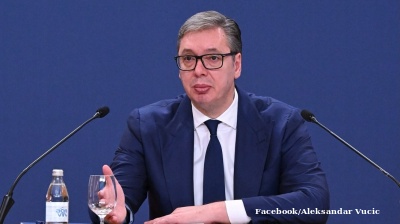When Volodymyr Zelenskiy, while still a Ukrainian presidential candidate, was asked about his childhood years in the Mongolian mining town of Erdenet, he said that he remembers one word very clearly – “baihgui”. It’s an expression that means “we do not have it”, and was illustrative of the deprivation of the time, when Mongolia’s independence from the Soviet Union was nominal at best and grocery store shelves empty. Today while Zelenskiy is leading his nation against Russian aggression, Moscow is working to secure Mongolia as a junior partner for a new strategically important natural gas pipeline to China.
The idea of a trans-Mongolian gas pipeline is not new and was revived by Mongolia’s pro-Russian President Battulga Khaltmaa at the 2018 Eastern Economic Forum. In 2019, with a tacit approval from Beijing, and Gazprom, Mongolia’s state-owned Erdenes Mongol launched a feasibility study of the construction of a Mongolian leg of the Power of Siberia 2 gas pipeline – known as the “Soyuz-Vostok” pipeline.
As bne IntelliNews reported, most of Russia’s oil and gas pipeline infrastructure goes west to deliver 60% of Russia’s oil and 70% of its gas to Europe. But with energy sanctions looming over Russia, it is scrambling to develop more gas and oil pipelines to Asia, where Moscow has more friends and willing customers. So far only the Power of Siberia 1 gas pipeline and Eastern Pacific-Siberian Ocean (ESPO) oil pipelines run east to the Asian markets, both of them built in the last decade.
In early 2022 Mongolian authorities and Gazprom approved the feasibility study, notwithstanding the fact that Power of Siberia 2’s feasibility study is still ongoing. A few days after the start of the Russian invasion of Ukraine, Erdenes Mongol and Gazprom speedily signed an agreement for the engineering and design work of the pipeline with the aim of starting construction in 2024.
During Putin’s recent visit to China for the Winter Olympic Games, a deal linking the Power of Siberia 1 with the Far Eastern Sakhalin-Vladivostok pipeline was signed, and parties further co-ordinated efforts on Soyuz-Vostok progress.
The Power of Siberia 2, and by extension the Soyuz-Vostok pipeline, has a capacity comparable to that of the suspended Nord Stream 2 projects of about 50bn cubic metres a year and is well-positioned to bring the Yamal peninsula’s production, which was originally destined for European markets, to China, thus completing the unification of Russia's gas transmission network.
Tough bargaining
In spite of having no expertise in developing natural gas pipelines, until now Ulaanbaatar has not engaged any third-party advisors in evaluating the technical and financial feasibility of the Soyuz-Vostok project. At the same time, Mongolia’s political leadership and Gazprom do not seem to be interested in involving a third party in the project, which could arguably increase transparency, provide additional capital and allow for greater scrutiny of the financial, engineering and environmental aspects.
As a result, Gazprom appears to have locked in Erdenes Mongol for a pre-determined set of technical and financial parameters, which will allow it to shift the unwarranted amount of total project cost onto the Soyuz-Vostok while leaving itself, or the Power of Siberia 2 pipeline, the lion’s share of the net profits.
Without a proper evaluation of the project and third-party involvement, Mongolia is likely to take on a sizable loan from Russia, possibly on predatory terms, to finance its portion of the costs, while agreeing to pay it off from the gas transit fees. In this scenario, ironically similar to the Soviet-era development of the Erdenet copper mine, Mongolia would be bearing heavy, possibly unjustified cost burdens, but make just enough for the project to break even, while not being able to secure long-term benefits such as scalable discounted gas supplies. Accordingly, negotiating on the transit fees, gas prices and project funding in an information asymmetry will be detrimental to Ulaanbaatar’s interests.
Moreover, there is little reason to believe that Mongolia will be able to shield itself from the political and geo-technical risks of Soyuz-Vostok, where a suspension of gas transmission could delay cash-flows, devalue Ulaanbaatar’s investment and further indebt it. Political risks in this case do exist, not only from the Russian side, which continues to block Mongolia’s attempts to build indigenous hydropower generation capacity, but also from China, which has a habit of closing borders and applying diplomatic pressure on Mongolia every time the Dalai Lama visits at the invitation of Mongolian Buddhists.
With the energy exports to the Western countries set to decrease, Putin’s urge to accelerate infrastructure connections to Eastern markets gives China a bargaining chip for a discounted pipeline gas supply deal. This new geopolitical reality will put pressure on Gazprom to squeeze the most it can get out of the Soyuz-Vostok pipeline, and leave Mongolia at a disadvantage.
Under the current circumstances, the risks of agreeing to a deal with Gazprom entail increased dependency of Mongolia on both Russia and China without meaningful economic benefits while further exposing itself to political risks and potential pressure on sovereign domestic matters from its neighbours.
Opinion

Armenia’s painful reorientation toward the West
Yerevan’s drive to break free from its dependency on Moscow is generating profound internal political turbulence and exposing it to new external risks, says a report by the Central Asia‑Caucasus Institute & Silk Road Studies Program.

COMMENT: Europe’s “fake it till you make it” war approach cannot hold off Russia’s trillion dollar war machine
In their speeches on the war in Ukraine, European leaders appear like a video clip looped on repeat. Standing before the cameras they declare new packages of support for Kyiv and threaten new measures to pressure Russia as if it was still 2022.

A year after the Novi Sad disaster, Belgrade faces one crisis after another
Serbia’s government is grappling with a convergence of crises which threaten to erode President Aleksandar Vucic’s once-dominant position.

Don’t be fooled, Northern Cyprus’ new president is no opponent of Erdogan, says academic
Turkey’s powers-that-be said to have anticipated that Tufan Erhurman will pose no major threat.




